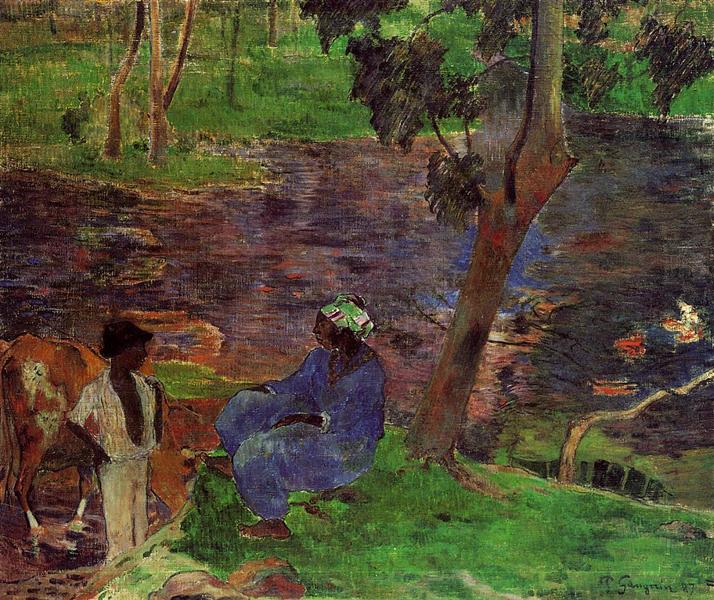Opis
Paul Gauguin's "At the Pond" (1887) is a fascinating depiction of nature through the singular gaze of an artist who moves away from the conventions of Impressionism to explore symbolism and emotional depth through color and form. In this painting, Gauguin invites us to contemplate a landscape where natural elements predominate, encompassing a pond that becomes the center of his composition.
In the foreground, rich green hues intertwine with earthy and yellow nuances that create a vibrant and vital atmosphere. The structure of the pond, with its gentle ripples reflected on the water’s surface, provides an interesting contrast to the rigidity of the surrounding bushes and trees. This handling of space reveals Gauguin’s ability to transform the landscape into an almost dreamlike experience. The edges of the pond are softly delineated, suggesting naturalness and fluidity, while the intentionality of his palette highlights a sense of calm and contemplation.
One of the most intriguing aspects of “At the Pond” is its playful use of color. The saturation of greens and blues, as well as the insertion of warm tones, seems to suggest an underlying energy within the painting. This palette not only describes what is seen, but also invites the viewer to feel, to envelop the view in an almost sensorial experience. Here one can observe how Gauguin began to distance himself from naturalistic representation towards a more symbolic approach, which would characterize later works.
While At the Pond presents a tranquil atmosphere, it lacks human characters that are often iconic in Gauguin's work. This decision can be interpreted as an exploration of the relationship between human beings and nature, stripped of figures that could interfere with the purity of the landscape or with the essence of the moment he wishes to convey. In this sense, the work fosters a connection between the viewer and nature, acting as a bridge between the artist's internal vision and the observer's perception.
Compositionally, the work employs a harmonious balance between the natural elements that make up the landscape. The pond, as the central figure, is surrounded by vegetation that highlights its importance. The attention to line and form reinforces the sense of depth and gives the eye a path to follow within the image, where every corner invites exploration. This careful structure reflects Gauguin's meticulous willingness to order the chaos of nature into a thoughtful and meaningful work of art.
At the Pond is a clear precursor to what would become Gauguin's signature language, where the search for spirituality through art and the idealization of the primitive became central to his work. Although this painting was created relatively early in his career, its defining elements prefigure his later exploration of the landscapes of Tahiti and the numerous works that blur the boundaries between realistic representation and symbolic expression.
The work, therefore, functions not only as a painted landscape, but as a vehicle for the exploration of a deeper interaction between the human being and his environment, a search that Gauguin would continue throughout his career. Thus, "At the Pond" stands as a work of considerable interest not only for its aesthetic quality, but for the way in which it encapsulates a time of transition in art, marked by the desire to break with past traditions and seek new truths through artistic expression.
KUADROS ©, a famous painting on your wall.
Hand-made oil painting reproductions, with the quality of professional artists and the distinctive seal of KUADROS ©.
Painting reproduction service with satisfaction guarantee. If you are not completely satisfied with the replica of your painting, we will refund 100% of your money.

